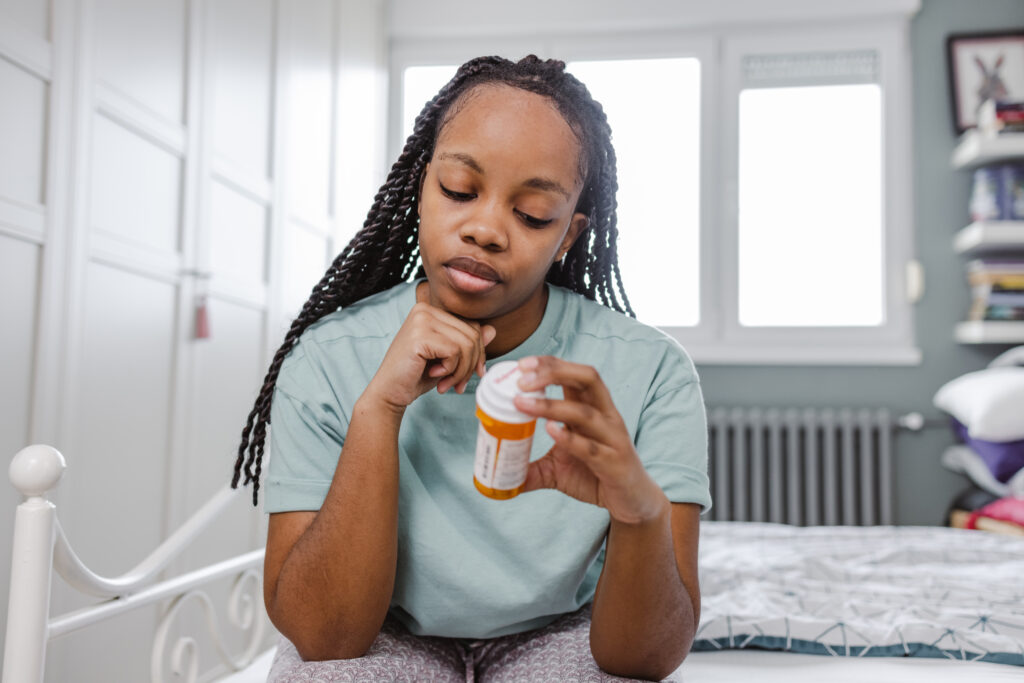Medical Review by Jennie Stanford, MD, FAAFP, DipABOM
Summary:
- Sertraline, marketed as Zoloft®, is an FDA-approved SSRI used to treat depression, OCD, and other mental health conditions.
- The medication works by increasing serotonin levels in the brain, which can help improve mood, stress management, and overall mental health.
- It’s important to be aware of the potential side effects of sertraline. These can include nausea, dizziness, insomnia, and sexual dysfunction, among others.
- Always consult with a qualified healthcare provider to determine whether sertraline is right for you
,and to ensure that you are taking an appropriate dosage.
An FDA-approved medication for multiple mental health challenges
Taking the right medication for depression or anxiety-related disorders can make all the difference to your treatment, so it’s important to learn about your options. Sertraline, commonly marketed as Zoloft®, may be worth considering.
In this article, you’ll learn more about sertraline—like how it works, what benefits it offers, and whether there are any side effects you should know about before you take it. Use this information to make an informed choice with your healthcare provider about the medication you use.
What is sertraline?
Sertraline is an FDA-approved SSRI medication that can be used to treat several different mental health conditions. Sertraline has similar effects as other SSRIs, but there are a few things that make it different from options like fluoxetine (Prozac®).
Learn more: Fluoxetine (Prozac®): Uses, Benefits, Side Effects, & More
How SSRIs work
SSRI stands for selective serotonin reuptake inhibitor. This is a type of medication that causes more serotonin to build up naturally in your brain by preventing it from being reabsorbed (a process called reuptake).
Serotonin is an important neurotransmitter—a chemical that helps regulate your mood and personality. When you have enough of it, you may see improvements in your ability to remember things, regulate your emotions, handle stress, and more.
What sertraline is used to treat
Because of its effects as an SSRI, sertraline is commonly prescribed to treat mental health conditions such as these:
- Major depressive disorder
- Obsessive-compulsive disorder (OCD)
- Panic disorder
- Post-traumatic stress disorder (PTSD)
- Premenstrual dysphoric disorder
- Social anxiety disorder (SAD)
But sertraline can work a little differently than some other SSRIs. We’ll explain what makes it unique in the next section.
How effective is sertraline?
Sertraline isn’t exactly like other SSRIs. One of the key differences is that sertraline may act more quickly to relieve anxiety than symptoms of major depression.
Does that mean sertraline isn’t effective for treating depression? Not necessarily. Another study suggests that the results of research performed on sertraline may underestimate how effective it is at treating depression in real-world settings.
Research from the American Journal of Psychiatry also shows that sertraline’s ability to treat anxiety disorders may correspond with reduced depression symptoms—as well as improvements in quality of life and overall satisfaction.
Side effects of sertraline
Like other medications, sertraline can have side effects ranging from mild to severe. Branded versions of the drug (like Zoloft®) carry the same potential side effects as generic versions, since the ingredients are the same. The most common side effects of Zoloft® fall into a few different categories, which we’ve listed below:
- Autonomic nervous system disorders: These may include problems ejaculating, sweating, or producing saliva in your mouth.
- Central and peripheral nervous system disorders: You could become sleepy, have a headache, get dizzy, feel a tingling or burning sensation, or get tremors.
- Gastrointestinal disorders: Sertraline can affect your appetite, as well as your digestion. You might also experience nausea or vomiting.
- Psychiatric disorders: Some people who take sertraline become more nervous or anxious, and can have trouble sleeping. You might also notice that your sex drive is lower than usual.
- Other side effects: Sertraline can cause abnormal vision, fatigue, and rashes.
Sertraline can also have other side effects, and some side effects may occur as a result of stopping your sertraline treatment. Always talk to your healthcare provider before starting, stopping, or adjusting your dosage of this medication.
Serotonin syndrome
SSRIs like sertraline can also cause a serious condition called serotonin syndrome, which can be fatal. Serotonin syndrome happens when your serotonin levels are too high, potentially impacting your mental state and the way your heart beats.
If you start to experience serotonin syndrome while taking Zoloft®, you might notice changes to your mental status (like hallucinations), or strange muscle reactions that could make you less coordinated. Nausea, vomiting, and diarrhea can also be telltale signs. Finding medical help fast is important in severe cases, so know the signs and contact your healthcare provider if you feel unwell when taking this medication.
Who should not take sertraline?
Sertraline can be an effective way to help treat the conditions it’s prescribed for, but it isn’t right for everybody. If any of the following risk factors for sertraline apply to you, your healthcare provider may decide not to prescribe it to you and could look for an alternative treatment:
- You are hypersensitive to any of the ingredients.
- You are using any medication classified as monoamine oxidase inhibitors (MAOIs) or have stopped taking them within the last 14 days. MAOIs are a kind of antidepressant that causes serotonin syndrome when mixed with SSRIs.
- You are taking pimozide (marketed as Orap®). This is a type of antipsychotic medication, which can cause problems that affect your heart when mixed with SSRIs like sertraline.
You should also be careful when taking sertraline with any other drug that could affect your serotonin levels, since this can increase your risk of serotonin syndrome. This includes other SSRIs and SNRIs, as well as certain other antidepressants, medications, and natural products like St. John’s Wort.
How to take sertraline
Using sertraline responsibly means understanding and following a few important guidelines. We’ve put together an overview below so you can have an informed conversation with your healthcare provider before seeking a prescription for this medication.
Getting a prescription for sertraline
You will need to talk to your healthcare provider before they can prescribe Zoloft® or generic sertraline to you. When you do, you should talk to them about your health history and lifestyle. Some of the information you may be asked about includes these:
- Whether you have any history of liver, heart, or kidney problems
- Your blood pressure and sodium levels
- If you have ever had seizures, convulsions, or stroke
- Whether you have bipolar disorder or mania
- If you have ever had bleeding problems
Only your healthcare provider can determine whether Zoloft® is right for you and what amount you should take.
Dosages of sertraline
Sertraline is taken by mouth, either as tablets, capsules, or a solution. It comes in the following dosages:
| 20mg/ml | 25mg | 50mg | 100mg | 150mg | 200mg | |
| Tablets | X | X | X | |||
| Capsules | X | X | ||||
| Solution | X |
The dosage of sertraline that you are prescribed will vary depending on your age, health status, and the condition you are using the medication to treat. The starting dose is 50 mg per day for adults who have major depression or OCD, which can be adjusted up to 200 mg if your healthcare provider decides it is appropriate.
When to take sertraline
If sertraline has been prescribed to you, you’ll take it once a day, during the morning or evening.
Find support for sertraline with Lemonaid Health
Whether you are considering medication for anxiety or depression, sertraline may be able to help. But it’s absolutely vital to talk with a qualified healthcare provider before obtaining or taking this medication so that you can use it responsibly and set yourself up for successful treatment.
Lemonaid Health can help by providing online consultations with medical professionals based in the US. These virtual visits can give you an easy way to learn more about sertraline and other medications, have your questions answered by experts, and even get a prescription if sertraline is right for you.
FAQ
How quickly can I expect results from taking sertraline?
Sertraline often takes 4-6 weeks to start working properly. However, you might begin to start feeling the effects after just 1-2 weeks. It’s different for everyone.
Can I take Zoloft® with alcohol?
The patient information for Zoloft® recommends avoiding alcohol while you take this medication. However, it also states that Zoloft® as an oral solution also contains 12% alcohol, and that taking Zoloft® will not make alcohol feel more potent.
Zoloft® is a registered trademark of Viatris Specialty LLC, a Viatris Company. Prozac® is a registered trademark of Eli Lilly and Company.












